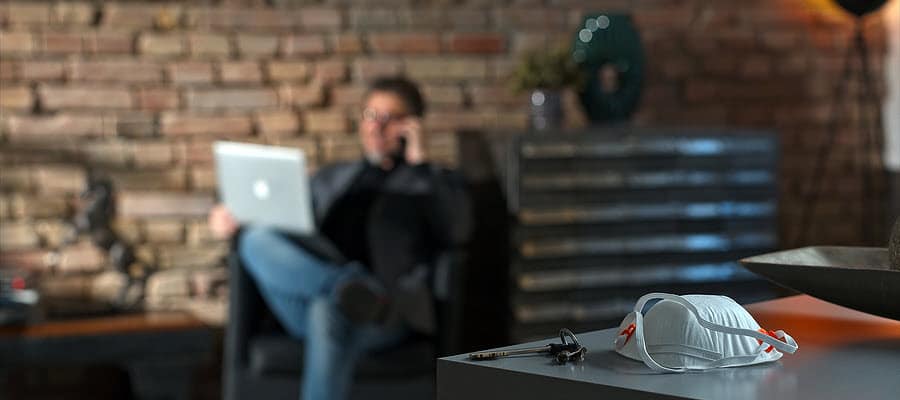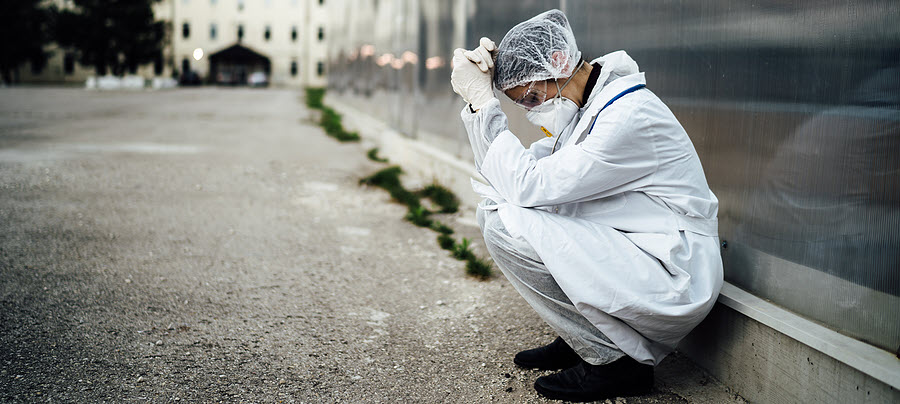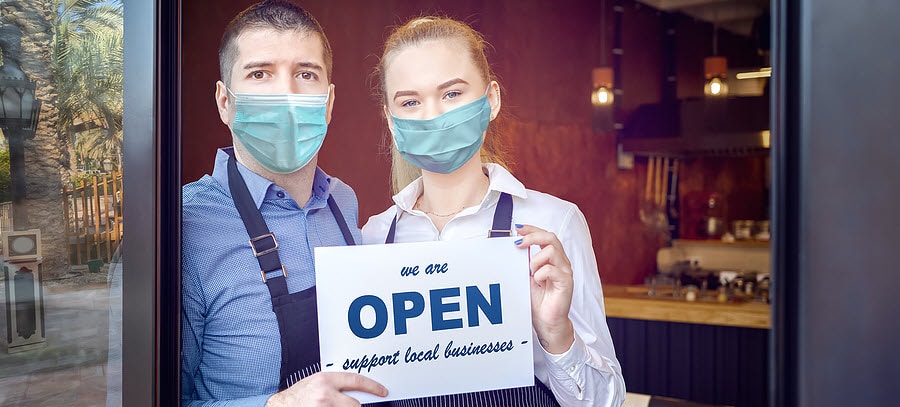Table of Contents
 This post on How to Naturally Treat PTSD is my response to the distress messages and comments I’ve received from COVID longhaulers over the last few years. Clearly, this is an ongoing problem that is not being addressed by mainstream medicine nearly enough in my humble opinion.
This post on How to Naturally Treat PTSD is my response to the distress messages and comments I’ve received from COVID longhaulers over the last few years. Clearly, this is an ongoing problem that is not being addressed by mainstream medicine nearly enough in my humble opinion.
Survivors of COVID-19 (SARS-CoV-2) are reporting problems with memory, sustained attention, executive function, anxiety, and depression.
But what many psychologists are coming to realize is the symptoms that COVID longhaulers are describing is often clinically known as Post-Traumatic Stress Disorder (PTSD).[i]
And it’s not only longhaulers suffering the after effects of this virus. It’s also millions of health care workers dealing with depression, anxiety, and PTSD.[ii]
Many will be dealing with the aftermath of this virus for years to come. The development of psychological support services is encouraging and hopefully will help many.
Medical professionals can and will offer support in the way of psychotherapy (talk therapy), antidepressants, benzodiazepines, or dopamine-blocking agents.
But if drugs and talk therapy is not your thing, and you’re looking for a natural PTSD alternative, you’re in the right place.
In this article you’ll learn to recognize the symptoms of post-traumatic stress disorder. And how neuroscience illustrates what PTSD does in your brain.
Then you’ll learn about some proven natural nootropic supplements that have been shown effective in helping people recover from PTSD.
What is PTSD?
The full syndrome of post-traumatic stress disorder (PTSD) was first defined in the Diagnostic and Statistical Manual of Mental Disorders (DSM-III), third edition of the American Psychiatric Association in 1980.[iii]
The American Psychiatric Association defined “a traumatic event was conceptualized as a catastrophic stressor that was outside the range of usual human experience”. They had in mind events such as war, torture, rape, the Holocaust, atomic bombings, natural and man-made disasters.
While most people exposed to traumatic events do not develop PTSD, others go on to develop full-blown syndrome.
The stressor ‘criterion’ specifies that a person has been exposed to a catastrophic event.
It could be a near-death experience of being put on a ventilator to help you breath. Or repeated exposure to the horrific consequences COVID-19 as a front-line health care worker, ambulance attendant, police officer, fire fighter, or body handler. Or simply the tole COVD has had on your body and brain.
 How to know if you have PTSD
How to know if you have PTSD
You can get and continue to experience the symptoms of PTSD for decades or even a lifetime. Symptoms usually begin within 3 months of the traumatic event. But sometimes can symptoms can show up much later.
For symptoms to be considered PTSD, they must last more than a month. And be severe enough to interfere in functioning relationships or work.[iv]
Re-experiencing symptoms
- Flashbacks – reliving the event over and over
- Nightmares
- Frightening thoughts
Avoidance symptoms
- Avoiding places, events, or objects that are reminders of the experience
- Avoiding thoughts or feelings related to the traumatic event
- Feeling detached or unable to connect with loved ones
Arousal or reactivity symptoms
- Hypersensitivity, easily startled
- Hypervigilance, feeling tense or on edge
- Difficulty sleeping, insomnia
- Irritability or angry outbursts
Cognition and mood symptoms
- Brain fog, trouble concentrating, loss of memory
- Depression, hopelessness
- Trouble remembering key features of the traumatic event
- Feelings of guilt or blame
- Loss of interest in enjoyable activities
- Headaches
Children with PTSD
- Wetting the bed after learning to use the toilet
- Forgetting how or unable to talk
- Acting out the scary event during playtime
- Being unusually clingy with a parent or other adult
But there is increasing evidence that PTSD isn’t just psychological. Several researchers have found a strong link between PTSD and inflammation and other immune responses.
A study published in the Journal of Psychiatric Research found elevated levels of c-reactive protein in survivors of the World Trade Center attack.[v]
The association between this biomarker and PTSD is so strong that some have proposed diagnosing PTSD with a CRP blood test.
 Post-Traumatic Stress Disorder and Your Brain
Post-Traumatic Stress Disorder and Your Brain
PTSD is a stress disorder. Neuroscientists at the University of California, Berkeley, found that chronic stress triggers long-term changes in brain structure and function.[vi]
Chronic stress changes neural networks. Cortisol creates a domino effect that hard-wires pathways between the hippocampus and amygdala. (The amygdala (lizard brain) is the area responsible for your fight-or-flight response).
This hard wiring caused by stress is not the way your brain was designed. But chronic, ongoing stress tricks your brain into rebuilding circuits and hunkering down for the long haul.
This re-wiring appears to be permanent. Unless you intervene with something like anyone of the nootropic supplements I’ll share with you in a minute.
Chronic stress seems to ‘flip a switch’ in stem cells in the brain. And turns them into a type of cell that prevents connections to the prefrontal cortex. Preventing improved learning and memory.
And laying down the scaffolding linked to anxiety, depression, and PTSD.
Chronic stress coats axons and neurons with myelin, reduces the number of neurons, and gray matter decreases while white matter increases.
Under conditions of chronic stress and excess cortisol, your brain’s neurons are coated (or sheathed) with myelin. Under healthy conditions this “sheathing” is a protective measure on axons only. Not the entire neuron.
This excessive sheathing is likely an evolutionary measure made to reinforce the connection between the hippocampus and amygdala. Which improves your fight-or-flight response during extended periods of threat or attack.
The chronic stress caused by pandemics and other natural disasters which result in PTSD hijacks your fight-or-flight response system.
It backfires in daily life after a traumatic event and in which you are no longer in physical danger.
 Best Nootropic Supplements for PTSD
Best Nootropic Supplements for PTSD
If you recognize any of the symptoms of PTSD even months after your traumatic experience – there is hope. You can recover from post-traumatic stress disorder.
Your doctor may prescribe antidepressants, benzodiazepines, or dopamine-blocking agents. And may refer you to a psychiatrist for talk therapy.
Or worse yet, something like ‘Prolonged Exposure’ therapy. Where you’re told to keep on reliving the event until you’re desensitized to it.
That sounds to me like cruel and unusual punishment. But if you’re brave, you may want to try it.
Instead, I recommend trying some natural nootropic supplements.
The following nootropics have been found in clinical studies, and in real life, to help reduce the symptoms of PTSD.
Each nootropic below has a live link that will take you to my full review for that dietary supplement. Including recommended dosage, side effects, and the best supplement to buy.
Ashwagandha
This ancient Ayurvedic herb, Ashwagandha has been used for thousands of years for its remarkable stress-relieving properties. It helps reduce anxiety and depression because it reduces the stress hormone cortisol, lowers blood sugar levels and improves cholesterol profiles.[vii]
Ashwagandha helps regenerate axons and dendrites and helps reconstruct synapses.[viii] Synapses are the junctions where neurons communicate with other neurons. It’s called brain cell signaling needed for boosting memory and restoring neural networks affected by severe stress like PTSD.
But Ashwagandha does so much more to relieve stress, anxiety, and depression. Go to the link above and read my full review for all the remarkable benefits this herb offers.
Just one example is a study done comparing Ashwagandha with the popular benzodiazepine antidepressant lorazepam (Ativan). And the tricyclic antidepressant imipramine (Tofranil).
The researchers concluded that as a mood stabilizer, Ashwagandha worked on depression and anxiety as well as either of the two anti-depressants.[ix]
Recommended dosage of Ashwagandha extract for PTSD is 250 – 500 mg per day.
Bacopa Monnieri
Bacopa Monnieri is a perennial aquatic herb originally from the wetlands of southeast Asia. Otherwise known as ‘water hyssop’, it’s often referred to as “Brahmi”. Named after the supreme god Brahma.
Bacopa’s two active components are bacosides A and B. They improve the signaling of electrical impulses between neurons in your brain. Bacosides also help rebuild damaged neurons. The same neurons damaged by chronic stress caused by PTSD.[x]
Bacopa also reduces stress and anxiety. Research at Banaras Hindu University in India showed Bacopa as effective for anxiety as the benzodiazepine drug lorazepam.
One of the side effects of lorazepam is memory loss. Bacopa Monnieri on the other hand, reduces anxiety while boosting cognition.[xi]
Recommended dosage for Bacopa Monnieri (45% bacosides) for PTSD is 450 mg per day.
Kava
Kava (Piper methysticum) is an herb that’s native the South Pacific islands. It’s traditionally been used in the islands as a hypnotic, psychotropic, and anxiolytic (anti-anxiety).
 Kava affects brain levels of GABA receptors. GABA is the ‘calming’ neurotransmitter. And an increase in receptor sites for GABA accounts for Kava’s anti-anxiety properties.[xii]
Kava affects brain levels of GABA receptors. GABA is the ‘calming’ neurotransmitter. And an increase in receptor sites for GABA accounts for Kava’s anti-anxiety properties.[xii]
California’s Global Neuroscience Initiative Foundation took a look at 24 studies of Kava and other herbal medicines for anxiety. And found substantial evidence that Kava relieved not only anxiety, but also restlessness and insomnia.[xiii]
They even looked at animal studies that showed Kava has anxiolytic effects “but not sedative or mental impairing” effects “which are typical side effects caused by benzodiazepines”.
Recommended dosage of Kava for PTSD is 250 – 500 mg per day.
Kratom
Kratom (Mitragyna speciosa) is the leaf of a tropical deciduous tree within the coffee family (Rubiaceae) native to Southeast Asia.
The compounds mitragynine and 7-hydroxymitragynine in Kratom are agonists of mu (μ) -, delta (δ) –, and kappa (κ) opioid receptors. Resulting in relief from pain.[xiv]
Kratom effects serotonin and norepinephrine pathways in the central nervous system providing relief from anxiety and depression.[xv]
And Kratom affects dopamine D1 receptors which helps boost energy.
A 2017 Grundman survey of 10,000 Kratom users aged 31 – 50 years, the majority having used Kratom from 6 months to 5 years, reported the following benefits: increased energy, decreased pain, increased focus, less anxiety, reduced or stopped use of opioid painkillers, and reduced PTSD symptoms.[xvi]
Recommended dosage of Kratom for PTSD is 1 – 15 grams per day. Dosage varies depending on the strain. For more on various strains and where to buy it see my full review on Kratom.
Lemon Balm
Lemon Balm (Melissa officinalis) is native to the Mediterranean region. And has a long history as a treatment for anxiety and depression.
Lemon Balm promotes GABA which acts as a glutamate inhibitor in your brain. Keeping glutamate levels in balance helps new cell growth which boosts memory and reduces stress.[xvii]
Rosmarinic acid in Lemon Balm works as an antidepressant. And boosts brain-derived neurotrophic factor (BDNF) which promotes the growth, maturation, and maintenance of brain cells.
Supplementing with Lemon Balm can provide an anti-anxiety effect within minutes of taking it. Some users say it works as well as popping a Xanax®.
Recommended dosage of Lemon Balm extract for PTSD is 300 – 600 mg per day.
Lithium Orotate
Lithium is a soft, silvery-white alkali metal and trace element considered essential for human health. The therapeutic use of lithium goes back to ancient Greek and Roman times. People enjoyed soaking in alkali springs to help with physical and mental illness.
Today lithium has an undeserved reputation as the ‘drug’ used to treat bipolar disorder and mania. But the clinical research on the neuroprotective benefits of lithium is so overwhelming, some scientists are beginning to ask, “why isn’t everyone using lithium”?
Here we’re talking about micro-dosing lithium in the form of Lithium Orotate for treating the symptoms of PTSD.
Lithium has been shown to prevent apoptosis, reduce glutamate toxicity mediated by NMDA-receptors, promotes BDNF needed for synaptic plasticity for learning and memory, and stimulates neuronal stem cells.
Supplementing with Lithium Orotate has been shown to stabilize mood and prevent depression and even suicide. Lithium Orotate will help put a stop to outbursts of rage and reduce anxiety.
If you are dealing with PTSD in the aftermath of a COVID-19, using Lithium Orotate could mean feeling excited about life again for the first time in a long time.
Anxiety and social anxiety are no longer a problem. Life is simply more fun and enjoyable.
If you’re dealing with insomnia, racing thoughts, or lack of motivation, I highly recommend trying Lithium Orotate and see how it works for you. Motivation could increase. And you’ll have more coping ability.
Recommended dosage for Lithium Orotate for PTSD is 5 mg 2 or 3-times per day, or as needed.
L-Theanine
L-Theanine is a non-dietary amino acid found in green tea (camellia sinensis). Its chemcial structure is similar to the neurotransmitters l-glutamate and l-glutamine.
 L-Theanine boosts alpha brain waves (8-12Hz) promoting alert relaxation[xviii]. And theta brain waves associated with creativity and relief from trauma.
L-Theanine boosts alpha brain waves (8-12Hz) promoting alert relaxation[xviii]. And theta brain waves associated with creativity and relief from trauma.
L-Theanine increases GABA, serotonin, and dopamine levels in your brain.[xix] As well as increasing Brain-Derived Neurotrophic Factor (BDNF) and Nerve Growth Factor (NGF). Producing an energizing and calming effect. And improving cognition and memory.
And L-Theanine is an antagonist of NMDA receptors which can inhibit synaptic release of glutamate. Protecting your brain from over-stimulation caused by glutamate, and possible glutamate toxicity.
You can get L-Theanine in capsule or tablet form, Recommended dosage of L-Theanine for PTSD is 200 – 400 mg once or twice per day.
My preferred way of getting L-Theanine is drinking 3 or 4 cups of green tea throughout my day. But extracting the optimal amount of L-Theanine from green tea is both an art and science.
Please see my full L-Theanine review for more on this remarkable nootropic including how to steep the perfect cup of green tea.
NADH
NADH is the active coenzyme form of Vitamin B3 (niacin) that is found in and critical for the health of every cell in your body and brain.
NADH is the primary carrier of electrons from glucose and lactate for ATP synthesis. ATP is your primary energy source created within your mitochondria.
The power supply in each of your brain cells. So, you need NADH to transfer the energy from the food you eat into a type of energy your body can use.
Research has shown that supplementing with NADH regenerates stem cells in your brain[xx], decreases anxiety[xxi], and reduces the symptoms of chronic fatigue.[xxii]
Some clinics in the USA and other countries are using NADH therapy as a treatment for addiction, anxiety, depression, chronic stress, and post-traumatic stress disorder (PTSD).
Recommended dosage of NADH for PTSD is 10 mg per day.
Rhodiola Rosea
The ancient remedy Rhodiola Rosea has remarkable stress-relieving and anti-anxiety properties. And stands shoulder to shoulder with some of the most potent drugs used to treat depression and anxiety.
Rhodiola Rosea helps in neurogenesis by repairing and growing new neurons. It also activates the synthesis and resynthesis of ATP, your body and brain cell’s main energy source.
Rhodiola Rosea helps reduce the inflammatory C-reactive protein which some professionals are considering using as a diagnostic tool for PTSD. And salidroside, one of many components of this incredible herb, protects neurons from oxidative stress-induced cell death.
Reports from the nootropics community, and data from clinical trials show that Rhodiola Rosea encourages a balanced mood.[xxiii]
And Rhodiola improves mental performance under stress. Studies have shown it increases the number of neurons in the hippocampus to normal levels. The same neurons lost from PTSD.[xxiv]
One study published in Phytomedicine evaluated the efficacy of using Rhodiola Rosea compared to the antidepressant sertraline (Zoloft©).
The research team concluded that even though Rhodiola offered slightly less antidepressant benefits, it possessed “a more favorable risk to benefit ratio for those with mild to moderate depression”.[xxv]
Recommended dosage of Rhodiola Rosea extract for PTSD is 200 mg per day.
SAM-e
SAM-e is the naturally occurring amino acid methionine bound to an ATP molecule. And is found in nearly every cell in your body. It helps produce and breakdown the neurotransmitters acetylcholine, dopamine, serotonin, norepinephrine, and melatonin in your brain.
Studies show that SAM-e is very effective in treating depression without the side effects of prescription antidepressants.
And while pharmaceutical antidepressants can take from 6 to 8 weeks to begin working, SAM-e can work much faster.
Scientists at the US Department of Health and Human Services conducted an analysis of 102 individual studies in 25 databases on SAM-e and depression.
In their report, the researchers concluded “Treatment with SAM-e was equivalent to standard therapy for depression”.[xxvi]
For optimal effects with SAM-e, stable, enteric-coated tablets are recommended. And taken on an empty stomach, either one hour before or two hours after meals.
One big word of caution: SAM-e needs Vitamins B6 & B12 and folate to work. Or SAM-e will elevate your homocysteine levels. High homocysteine can cause heart attacks.
Recommended dosage of SAM-e for PTSD is 400 mg per day.
St. John’s wort
St. John’s wort is a potent antidepressant. It has been used to treat a variety of internal and external illnesses dating back to the ancient Greeks.
St. John’s wort inhibits the uptake of serotonin, dopamine, GABA, glutamate, and norepinephrine. Inhibiting the neuronal uptake of these neurotransmitters can have a profound effect on depression and anxiety.
St. John’s wort extract decreases oxidative stress, prevents neurotoxicity, and brain inflammation. It helps maintain mitochondria electric potential in brain cells.
And St. John’s wort moderates the genes controlling the function of your HPA-axis which is directly related to symptoms of anxiety and stress.
In 1977, the British Medical Journal published a meta-analysis of 23 previously published studies on St. John’s wort drawn from foreign medical journals.
The analysis showed that overall, St. John’s wort was significantly superior to placebo. And as effective as pharmaceutical antidepressants.[xxvii]
The same journal published another study in 2005 showing that St. John’s wort was equally effective in treating depression and better tolerated than the widely prescribed antidepressant paroxetine (Paxil®).[xxviii]
St. John’s wort has been extensively studied for treating a wide range of health disorders including PTSD. To see more of these studies, click the live link above to go to the full review of this amazing nootropic herb.
But dosage of St. John’s wort and choice of supplement can be complicated. So please refer to my full review here.
NOTE: you should NOT use St. John’s wort if you are taking any kind of antidepressant medication. For a full list of precautions, see my full St. John’s wort review.
 Post-Traumatic Stress Disorder is Manageable
Post-Traumatic Stress Disorder is Manageable
PTSD is not an impossible nut to crack no matter what they say. Instead of re-living the horror of the trauma you were dealt with using ‘Prolonged Exposure’ therapy. Or dealing with the side effects or outright failure of antidepressants.
Try natural nootropic supplements instead. And put your life back together. You can recover.
You will likely have to do some experimenting on your own. Use the information in this article and follow the links through to my full review of each nootropic mentioned here. Thousands in our community have been where you are now. We’re here to help. All you need to do is ask in the Comment section below this article.
I recommend starting with a combination of 3 or 4 of the natural nootropic supplements I detailed above.
If you’re new to this please don’t take them all at once. Start with one supplement and use if for a couple of days. If you don’t experience any adverse effects, add the next supplement on the list. And so on.
If one nootropic doesn’t seem to be providing any benefit then try another from the list above. Follow the dosage recommendations for each supplement.
Keep at it until you feel relief from the PTSD symptoms you’ve been dealing with. And get your life back with these safe, natural treatments for PTSD.






Join The Discussion - 8 comments
Hannah
March 7, 2023
Hello David –
Any thoughts on the following study and dosage? I have researched and cannot find the recommended combination. Also, conflicting info on the vitamin A. Your thoughts and time are appreciated.
“Reduction of DNMT3a and RORA in the nucleus accumbens plays a causal role in post-traumatic stress disorder-like behavior: reversal by combinatorial epigenetic therapy” by Gal Warhaftig, Noa Zifman, Chaya Mushka Sokolik, Renaud Massart, Orshay Gabay, Daniel Sapozhnikov, Farida Vaisheva, Yehuda Lictenstein, Noa Confortti, Hadas Ahdoot, Avi Jacob, Tzofnat Bareli, Moshe Szyf & Gal Yadid. Molecular Psychiatry
Hannah
March 7, 2023
I should have added this as well.
https://neurosciencenews.com/nutritional-supplements-ptsd-19078/
Thank you
David Tomen
March 8, 2023
Hannah, that study demonstrates success in treating PTSD by supplementing with SAM-e and Vitamin A. But these are animal studies so dosage is not relevant to humans. For human use I suggest following adult dosage recommendations. For SAM-e (https://nootropicsexpert.com/sam-e/) 400 mg per day with a BioActive B-Complex, and for Vitamin (retinyl palmitate) A 1,000 mcg per day.
You can decrease your dose of SAM-e once you notice some benefit. And keep in mind both of these supplements are fat-soluble to must be taken with food containing a healthy fat or a tablespoon of unrefined coconut oil or olive oil to ensure absorption.
David
February 6, 2023
Hi david, last couple of years i have been thru an extreme burnout caused by long term stress. I even to this day (5 years later) have all kinds of problems and im always in a stressed state and cant relax
I read that bacopa and theanine could help restore my brain from long term stress. I have already tried ashwagandha and it helped with the stress but gave me sleep problems and i always felt dizzy while on it and gave me more brainfog.
Right now i take
Tryptophan
Tyrosine
Taurine
Gaba
Magnesium
And all this helps me alot with my depression
Is it safe to add theanine and bacopa on to my stack?
In the future im also gonna add
DHA
Lions mane
Performance lab energy
David Tomen
February 9, 2023
David, yes it is safe to add L-Theanine and Bacopa Monnieri to your stack. You likely has problems with Ashwagandha because it messes with thyroid hormones.
LB
April 18, 2021
Hi dave
Have you covered repairing brain from taking psychotropic pharmaceutical drugs ?
David Tomen
April 19, 2021
LB, I haven’t written about it but have researched it a little for personal consultations. And it’s complicated. Not sure there is enough research to publish something that you can use. I’ll take a closer look as I know there are a lot of people in our community who could use it.
Tristan
October 31, 2021
Hi David,
I can totally relate to this. Ever since I got Covid last year, my life changed.
It was mild but it definitely got to my brain.
I suffer from severe anxiety and depression now and as they daylight decreases it makes it worse.
Sometimes just getting through the day is tough.
I didn’t use anti depressants so far but I think I will have no other option.
I’ll try lithium orotate first.
Thank you